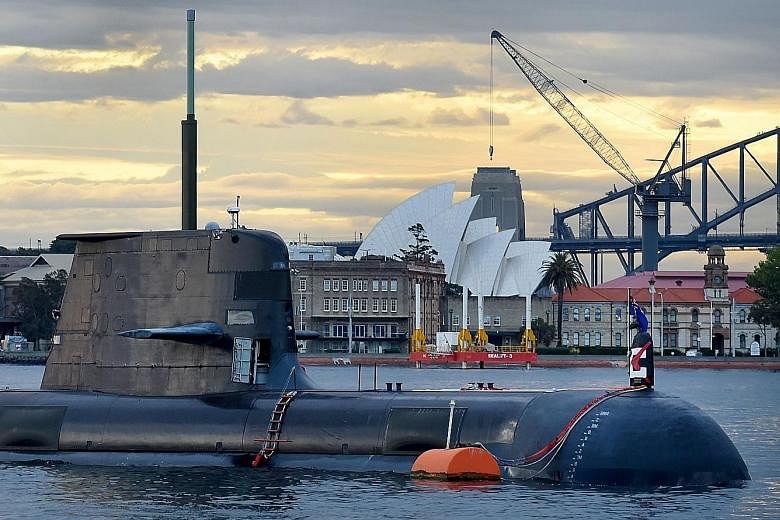Standing beside the nation's most powerful warship, Australia's Prime Minister, Mr Malcolm Turnbull, appeared to have chosen the perfect backdrop for his announcement last Tuesday of a landmark A$89 billion (S$92 billion) naval shipbuilding programme.
Outlining the "nation-building" plan, Mr Turnbull stood in the shadow of the country's new 146.7m-long air warfare destroyer, the HMAS Hobart. The ship was docked at the Osborne naval shipbuilding yard in Adelaide, where it was constructed.
"This is the largest investment in our defence capability of our navy ever in peace time," Mr Turnbull declared. "This is a continuous shipbuilding commitment, not just for today and tomorrow, but for generations to come."
The government last week unveiled a 114-page Naval Shipbuilding Plan that includes detailed proposals and timelines for the construction over the next 40 years of the nation's new navy capabilities. This includes 12 submarines, nine anti-submarine frigates, 12 patrol vessels and 19 patrol boats to be given to Pacific island countries.
This new assortment of vessels will mark the biggest boost to the navy since World War II.
To be completed by 2050, they are part of Australia's long-term ambitions to build up its navy and improve its defence capabilities amid potential threats, such as growing tensions in the South China Sea. The plan says thousands of jobs will be created - with about 5,000 new positions expected to boost the state of South Australia's struggling economy.
"These new capabilities... will be critical to the Australian Defence Force's ability to conduct independent combat operations to defend Australia and protect our interests in our immediate region, and contribute to global coalition operations," the plan says.
-
BEEFING UP THE NAVY
-
Australia's $92 billion naval build-up includes:
TWELVE FRENCH-DESIGNED SUBMARINES
To be built from 2022/23 to late 2040s
NINE FRIGATES
To be built from 2020 to late 2030s
TWELVE OFFSHORE PATROL VESSELS
To be built from 2018 to 2030s
NINETEEN PACIFIC PATROL BOATS
To be built from 2017 to 2025
But analysts were quick to question whether the timelines and budgets will be achieved. And they needed to look no further than the backdrop.
Despite the HMAS Hobart successfully completing sea trials in March, it is part of a three-ship project that is about three years behind schedule and costs at least A$1.2 billion more than planned.
This has long been the problem facing the nation's haphazard attempts to build its own ships and submarines. Despite the government's push to ensure that defence spending leads to extra jobs, analysts have questioned whether Australia has the capabilities - and the commitment - to deliver highly sophisticated vessels within reasonable costs and time frames.
A former rear admiral and an expert on Australia's navy, Professor James Goldrick from the University of New South Wales's Australian Centre for the Study of Armed Conflict and Society, said the shipbuilding plan was large in scale but could succeed if properly funded and monitored. He said Australia needed to avoid smaller projects because "there is always a learning curve which reduces the prices after the second or third build".
"If you're going to build warships yourself, you need to do it on a sufficient scale with sufficient numbers and sufficient continuity," he told The Straits Times. "Then the learning curve cuts in."
Most analysts agreed, welcoming the 114-page plan's proposals for a continuous run of construction which would help to reduce waste and ensure skills are maintained.
The plan features a A$1.3 billion upgrade of the Osborne shipyard and the Henderson facility in Western Australia, including construction of new cranes and welding stations. To boost local skills, there will also be a A$25 million naval shipbuilding college established in Adelaide, which will produce about 1,500 graduates a year.
Former naval officer Graeme Dunk, a PhD candidate at the Australian National University, said the plan would help to strengthen the navy's capability and the skilled workforce. But he said it was largely focused on construction and paid little attention to boosting skills needed for maintaining vessels and developing combat systems and weapon elements.
"The naval shipbuilding plan is undoubtedly a major step forward for industrial capability in Australia," he wrote on The Conversation website last Thursday.
But the plan also raised questions about whether Canberra has properly explained the need for such large-scale military spending.
An editorial in The Age newspaper suggested that Mr Turnbull's backdrop at the Osborne shipyards was aimed squarely at his own political fortunes and the need to shore up votes in South Australia, a clear reference to his poor standing in opinion polls and his government's razor-thin majority in the Lower House of Parliament.
"The government owes taxpayers an honest explanation for the proposed naval expansion or should admit this massive spending is far more about its own electoral security than that of the nation," the newspaper stated last Wednesday.

